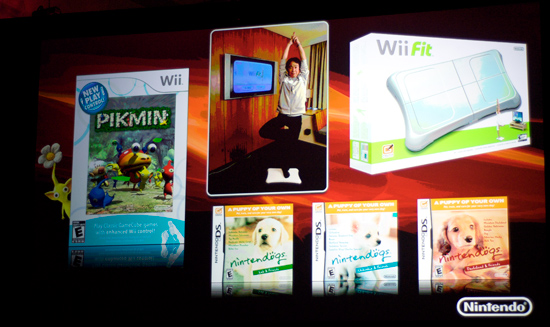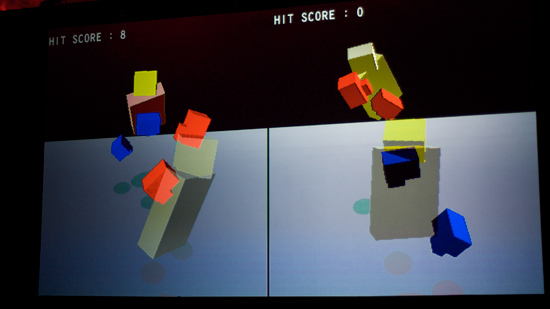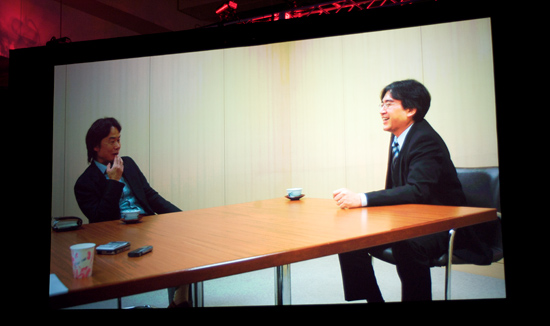Nintendo's Development Secrets, Cloud Gaming & new Killer NIC - GDC '09
by Anand Lal Shimpi & Derek Wilson on March 26, 2009 12:00 AM EST- Posted in
- Trade Shows
Miyamoto’s World
Miyamoto draws his inspiration from observation. He looks at other humans and watches how they interact, what they enjoy doing, etc... When he sees an activity that people enjoy he focuses on why they find that activity so entertaining. He thinks about things that most people just glaze over; most people know when they’re having fun, they don’t focus so much on why they’re having fun. He analyses himself and others in order to discover new ways to develop games that capture the fun people already know how to have. Miyamoto draws his inspiration from the life around him; he doesn’t sit down to make a game, he looks at what he and others enjoy in life and uses that to spark the innovation.
Iwata gave two examples; the first was when Miyamoto got a new garden, Pikmin shortly followed. And when Miyamoto got a new dog? Nintendogs came about.

With the idea in mind, Miyamoto uses basic personal communication to start talking about it. He grabs a very small team and doesn’t do anything formal, they just talk. Miyamoto is all about personal communication, and that’s what happens here.
The next stage is to take this small team and begin prototyping the game. There’s no need for polish here, or anything other than the core concept of the game. As an example, this was the original prototype of Wii Boxing:

It’s not particularly attractive. There are no impressive shaders being used here. Miyamoto simply wants to test the basic mechanics of the game to see if it’ll be fun. The prototype stage is only concerned with the simple idea itself; don't worry about extraneous details - just core gameplay.
These small prototyping teams are sometimes only one developer large. There are often multiple projects in the prototype stage at the same time. This prototype stage can sometimes last as long as two years; not every concept ever makes it out of this stage, but Miyamoto never throws away the work that’s been done. While a prototype game or feature may not be used for the current project, it may come in handy somewhere down the line. Iwata said that he often times saw prototypes show up in games further down the line in ways you’d never expect.
It’s impossible to know what will be fun without trying it first. Miyamoto employs extensive use of trial and error in his prototyping stages, but that’s the beauty of not building fancy prototypes. If the concept doesn’t work, there’s not much extraneous work lost - it was simply a learning experience.

Miyamoto (left) and Iwata (right)
When a prototype succeeds, then and only then can the game get to a planning stage. This is where the documents come out and we start seeing some structure. With the core gameplay already defined, the next stage is mass production where the actual game is put together. The approach is very front loaded; if the core gameplay is done properly thanks to a well executed prototyping phase, building the rest of the game can go smoothly and according to schedule.
While the mass production stage is usually predictable, sometimes it does yield surprises. One of Miyamoto’s traits is that he never gets angry with his team when things don’t go according to plan. Mistakes are made and instead of a yell-fest, Miyamoto will even go as far as to personally help get things back on track. Iwata talked about it like someone turning a table upside down; Miyamoto helps pick up the pieces and put it back in order, rather than complain about the mess that was just made.

Because of Miyamoto’s aggressive focus on the prototyping stage, a game never needs to be restarted from scratch once it’s at the mass production phase. The prototype stage produced a well defined core concept. Sometimes ideas need to be dropped from the title because they don’t work out, but as I mentioned before, Miyamoto saves the ideas and can reuse them in later completely unrelated projects.
Iwata spoke of the “Death Spiral” in game development. Game developers face financial pressure to get games out on time; the developers rely on game sales to fund both current and future projects, so without that revenue stream there’s no hope for game development to continue. The financial pressure leads to less time to work on and perfect a game, which then leads to poor quality and poor sales. The spiral continues downwards until the developer can no longer remain competitive in the industry.
Iwata himself saw this death spiral first hand, as his previous job as a developer left him with 2 days to ship a title that needed months worth of work. Iwata sacrificed the quality due to sales pressure and eventually had to help restructure his company (HAL Laboratory) for bankruptcy. A much younger Iwata blamed finances alone for his employer’s failure as a game developer, but today Iwata believes that it has just as much to do with talent and approach to game development. His change in perspective is thanks to one man in particular: Shigeru Miyamoto.
According to Iwata, it’s Miyamoto’s methodical yet youthful approach to game development that gives him, and thus Nintendo, the edge. Iwata’s goal was to share one of Nintendo’s secrets success with the game developers in the audience. I just liked knowing how someone as significant as Miyamoto goes about his job.










38 Comments
View All Comments
blagishnessosity - Thursday, March 26, 2009 - link
The way I see it, broadband speeds are decreasing. A decade ago when my family first got road runner, few other families in the neighborhood had it, so there was not nearly the amount of network usage that we see today. Now, everyone has broadband and usage is high, slowing down the network. Now the ISP's are charging more for inferior speeds. In my experience, bandwidth tests back then yielded much higher speeds then they do now. And not just that, I pay more money for less speed (I've always used road runner). So, maybe the technology exists for higher speeds now, but you have to pay a high premium for them. There doesn't appear to be enough competition in the ISP market for this trend to change anytime soon.XiroMisho - Thursday, March 26, 2009 - link
I originally thought this was bloatware... until I tried to do voice chat on a system with a sub par sound card. For the price, and the fact it has voice chat support... then okay, vs buying a better sound card on PCI-E (Which... doesn't exist for under a $150, thank you lethargic sound card community...), this may be worth it... of course going to wait till the price drops to about $79.99.Calin - Thursday, March 26, 2009 - link
This won't help if you're having a sub par sound card. It's like buying larger tires for better grip when you're using a Yugo to tow a large trailer, or somethingBigfootSean - Tuesday, March 31, 2009 - link
Well, sorta. Currently, lots of game voice apps rely on the CPU to do all the encode / decode operations required for gaming voice chat. Sound cards do a good job at DirectSound / EAX sort of stuff, but when it comes to more random stuff like voice, both the apps and the cards develop out of sync.It makes sense for us to do this (and sign up as many partners as possible) because voice chat is a network app that should run on the NIC. Let the CPU worry about the game, let the audio card worry about the explosions and effects, and let the network processor slice, dice, decode, encode and send.
Combined with hardware bandwidth control, this means that your game will never step on your voice chat, and vice versa, assigning clear priorities to each so that neither becomes scrambled.
Thanks for the opportunity to reply!
Lifted - Thursday, March 26, 2009 - link
I still have to play with my friends wii's. :(NewBro - Thursday, March 26, 2009 - link
I'm sorry but am I the only one who thinks the whole OnLive gaming on internet is a terrible idea to start with? First of all the latency issue, and the whole thing running through the internet just doesn't sounds all that great to me. I mean would you want to be interrupted in the middle of a Boss fight in Resident Evil 4 due to a bad connection?xahydra - Sunday, March 29, 2009 - link
Yeah, this whole cloud stuff is getting a little wacky now... Sure there are some really useful services, but it bothers me to see some people get so excited about handing their hardware over little by little and depending on someone else to run their software. I don't want a future filled with dumb terminals that can be managed and controlled more than ever by someone else. The P in PC is for Personal. Its bad enough I have to ask for Microsofts permission to activate my OS when I swap out a peice of hardware. I don't want "subscription software" and "on-demand" gaming... I can pull out my old copy of Freespace 2 and play it at will because it's MINE, I don't have to navigate to the "classics channel" and pay to play over a streamnubie - Friday, March 27, 2009 - link
Personally the ramifications of this are easy to see if you imagine that you could have a server that streams the game to any display you want in or around your house.Instead of having a monster gaming machine tethered to a desk making heat and noise you could have wireless handheld consoles, from the iPhone to the PSP/DS, or even something much slimmer with a 10" screen on a magnesium or aluminum chassis and hours upon hours of battery life. Not to mention streaming to displays all over your house, from the projection room to the kitchen.
What about inviting people over for a "LANparty" without the LAN. Imagine the latency reduction of having everyone on the same system. I can, I already use nVidia dual-view to load up games with split-screen and split-controls onto my PC, and it is a blast (not that these games are common, only a handful of titles at best.)
SLi and Crossfire don't seem particularly interested in allowing users to span 2-8 displays of multi-player goodness from one machine, even though the results are stunning.
The0ne - Thursday, March 26, 2009 - link
I don't think it will work at all when there are tons of users. Sure a few demos and players here seems fine now but just wait til you're at WOW numbers :)Samus - Thursday, March 26, 2009 - link
It makes sense for games like World of Warcraft where latency isn't a big deal...although WoW isn't very graphically intensive to begin with so the service is for the most part unneccessary.FPS's = I agree with you. Latency is ALREADY a problem in deathmatch, and that's measured in milliseconds. I'm sure the video latency will be at least a second.